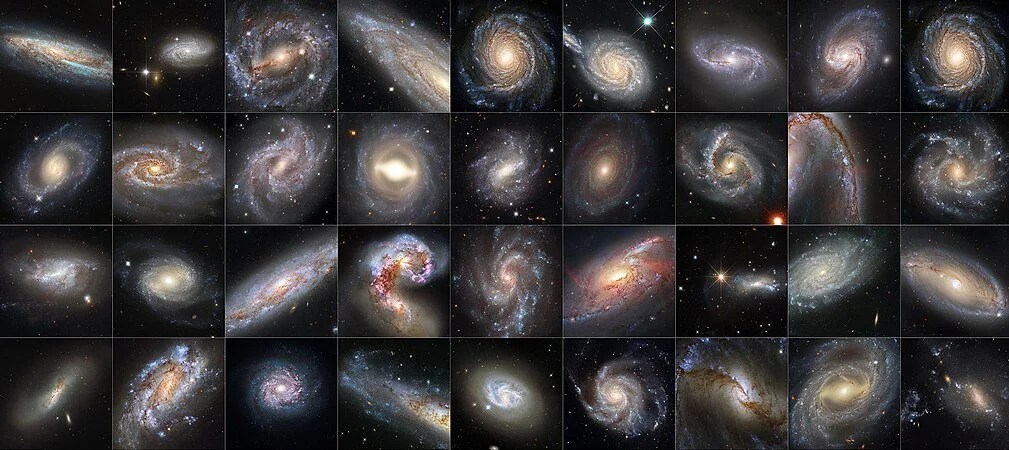Galaxies are vast assemblies of stars, gas, dust, and dark matter, bound together by gravity. They exhibit a diverse range of shapes and sizes, leading to their classification into several primary morphological types:
1. Spiral Galaxies: These galaxies feature a flat, rotating disk structure with prominent spiral arms extending from a central bulge. The arms are rich in gas and dust, serving as active sites for star formation. Spiral galaxies are further categorized based on the prominence of their central bulge and the tightness of their spiral arms:
Sa: Large central bulge with tightly wound arms.
Sb: Moderate-sized bulge with moderately wound arms.
Sc: Small bulge with loosely wound, well-defined arms.
2. Barred Spiral Galaxies: Similar to spiral galaxies but distinguished by a linear, bar-shaped structure of stars extending through the central bulge, with spiral arms originating from the ends of the bar. The Milky Way is an example of a barred spiral galaxy. They are classified as:
SBa: Prominent central bulge with a pronounced bar and tightly wound arms.
SBb: Moderate bulge with a distinct bar and moderately wound arms.
SBc: Smaller bulge with a noticeable bar and loosely wound arms.
3. Elliptical Galaxies: These galaxies exhibit an ellipsoidal shape with a smooth, nearly featureless brightness profile, lacking the distinct structures seen in spiral galaxies. They contain older, low-mass stars and minimal interstellar matter, indicating little to no ongoing star formation. Elliptical galaxies are classified based on their elongation, from nearly spherical (E0) to highly elongated (E7).
4. Irregular Galaxies: Lacking a defined shape or structure, irregular galaxies do not fit into the spiral or elliptical categories. They often contain abundant gas and dust, leading to active star formation. Their irregular appearance can result from gravitational interactions or mergers with other galaxies.
Galaxy Interactions and Evolution: Galaxies are not isolated; they frequently interact and merge with one another. Such interactions can lead to the formation of peculiar galaxies with distorted shapes and can trigger bursts of star formation. Over time, these processes contribute to the evolution of galaxies, influencing their morphology and star-forming activity.
Understanding the classification and behavior of galaxies is fundamental in the study of cosmology and the large-scale structure of the universe.
Now read the Chapter Galaxies in the Openstax Astronomy textbook.
Self-Evaluating Questions
Try answering these questions after completing the reading. If you find any difficult to answer, revisit the textbook to reinforce your understanding.
-
a) High populations of old stars
b) A flat rotating disk with spiral arms
c) A smooth, featureless brightness profile
d) A wide range of sizes from dwarfs to giants -
a) It lacks spiral arms
b) It has a central bulge but no disk
c) It contains a bar-shaped structure across the center
d) It is composed only of old stars -
a) Elliptical galaxies
b) Irregular galaxies
c) E0-type galaxies
d) Giant ellipticals -
a) The presence of a large black hole
b) Rotation around the galactic center
c) A recent or ongoing galactic collision
d) A deficiency of dark matter -
a) Mostly young, massive stars in star-forming regions
b) A mix of new stars and planetary nebulae
c) Old, low-mass stars with little interstellar gas
d) A disk of gas and spiral arms -
b) A flat rotating disk with spiral arms
c) It contains a bar-shaped structure across the center
b) Irregular galaxies
c) A recent or ongoing galactic collision
c) Old, low-mass stars with little interstellar gas

